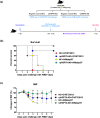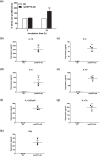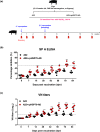The HSP70-fused foot-and-mouth disease epitope elicits cellular and humoral immunity and drives broad-spectrum protective efficacy
- PMID: 33772029
- PMCID: PMC7998017
- DOI: 10.1038/s41541-021-00304-9
The HSP70-fused foot-and-mouth disease epitope elicits cellular and humoral immunity and drives broad-spectrum protective efficacy
Abstract
Current foot-and-mouth disease (FMD) vaccines have significant limitations, including side effects due to oil emulsions at the vaccination site, a narrow spectrum of protective efficacy, and incomplete host defenses mediated by humoral immunity alone. To overcome these limitations, new FMD vaccines must ensure improved safety with non-oil-based adjuvants, a broad spectrum of host defenses within/between serotypes, and the simultaneous induction of cellular and humoral immunity. We designed a novel, immune-potent, recombinant protein rpHSP70-AD that induces robust cellular immunity and elicits a broad spectrum of host defenses against FMD virus (FMDV) infections. We demonstrated that an oil emulsion-free vaccine containing rpHSP70-AD mediates early, mid-term, and long-term immunity and drives potent host protection against FMDV type O and A, suggesting its potential as an FMD vaccine adjuvant in mice and pigs. These results suggest a key strategy for establishing next-generation FMD vaccines, including novel adjuvants.
Conflict of interest statement
The authors declare no competing interests.
Figures







References
-
- World organization for animal health. Terrestrial animal health code. 26th ed. OIE; Paris, France (2017).
-
- Yang M, Holland H, Clavijo A. Production of monoclonal antibodies against whole virus particles of foot-and-mouth disease virus serotype O and A and their potential use in quantification of intact virus for vaccine manufacture. J. Vaccin. 2008;26:3377–3382. doi: 10.1016/j.vaccine.2008.04.062. - DOI - PubMed
LinkOut - more resources
Full Text Sources
Other Literature Sources

